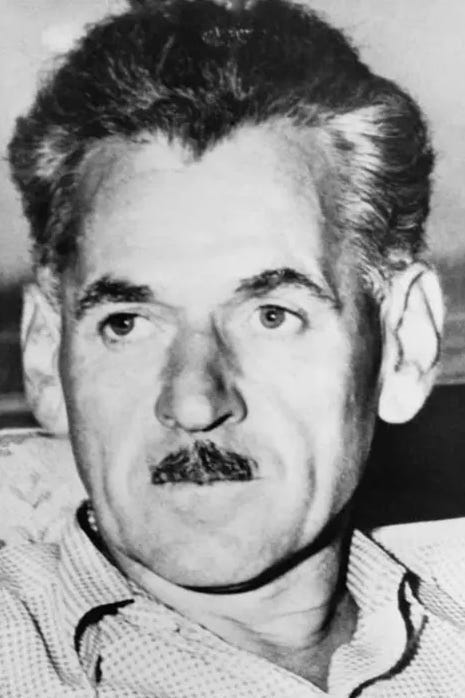THE PLAN
During 1944, it became obvious that the war in Germany would soon be over. Allied leadership believed there needed to be a post-war plan. Other individuals also had similar ideas. Responsible for such a plan would be two powerful individuals: US Secretary of the Treasury Henry Morgenthau Jr. and Treasury official Harry Dexter White. Overseeing this would be Secretary of State Cordell Hull.
Who were these two individuals? It could be considered rather odd to employ individuals from the Treasury to draw up such plans, especially individuals like Morgenthau or White, who seemingly held no allegiance to America or the West. In fact, Whitaker Chambers and Elizabeth Bentley - two undercover Soviet spies who were put on trial - both testified that Harry Dexter White was a high-level agent of the Soviet Union. Despite this revelation, White would go on to play a key role in the organisation of what we know today as the World Bank and the International Monetary Fund.
Morgenthau, on the other hand, was not directly tied to the Soviet Union, but his loyalty to the United States was questionable at best. He displayed a hostility toward both the German people and Christian values. It was these Christian values that were understood to be the guiding principles for the Western Allies. Both Morgenthau and White were closely associated with Roosevelt, with Morgenthau understood to be perhaps Roosevelt's closest associate for a time.
White and Morgenthau got to work on the post-war plan. It would become a blueprint for the destruction of Germany through the forced de-industrialisation of the entire country, the flattening of the Rhineland industry, the closing down of farms, and the removal of any remaining infrastructure which would allow for a functioning economy. This was nothing short of a plan for genocide. Early estimates by Herbert Hoover foresaw 25 million German deaths. Despite this foresight, from January to September 1944, Morgenthau and White pushed their plan forward while Roosevelt quickly supported it. It remains a matter of speculation as to why the Treasury Department was given authority to draw up such plans, although White’s Soviet influence must have played a significant role.
During the planning, Morgenthau noted that White would often and rather suspiciously arrive with some plans already pre-drafted. White was closely tied to two other high-level Soviet agents. One of them was Rudolph Blum (under the false name Rudy Baker), who oversaw covert operations at the Communist Party USA. Blum had taken over after Whitaker Chambers had defected and implicated White in a communist conspiracy. The other was Nathan Silvermaster, once a part of the US War Production Board and a high-level agent responsible for coordinating communist spies within the US government. He would later be exposed by the defected Soviet spy Elizabeth Bentley. Both Silvermaster and Blum likely had direct control over White. This is, however, just the tip of the iceberg; Roosevelt’s administration was packed full of Communists with dual allegiances.
During the early half of 1944, White learned that the State Department was drawing up its own post-war plans for Germany, which would be far more lenient. In fact, the State Department's plan had limited reparations so as not to destroy the population and would encourage rapid reconstruction to allow Germany to partake in a post-war democratic Europe. Driven by what can only be described as a genocidal hatred for the German people, Morgenthau and White were angered by this news and set about convincing Roosevelt to stay on board with their plan which, as Morgenthau put it, would “punish the German people, not just the Nazis. We either have to castrate the German people or treat them in such a manner that they can’t go on creating people who want to go on the way they have in the past.”
Roosevelt was clearly on board with Morgenthau, who was a major donor to his Democratic Party. Henry Stimson, the man responsible for the more lenient plan, however, was not close to Roosevelt, and thus his plan was not prioritised at all. The updated plans from Morgenthau included the extermination of 50,000 German officers without trial - a reference to something Stalin had mentioned a year earlier. It also included plans for the complete de-industrialisation of Germany - particularly in the Ruhr - and the stripping of all infrastructure which would allow for a functioning economy. This was not only heavy industry but coal, electrical, chemical, and metallurgical industries.
The country would then be split up into several zones to be governed by various powers, most prominently an international zone which would be used to extract resources as reparation. Harry Dexter White - who was in charge of this element - left the specifics surrounding the partitioned international territories up in the air, but given that he and half a dozen Soviet agents had a hand in writing this plan, it is obvious that this meant ceding the resources directly to the Soviet Union. This would have been truly genocidal, as the plan also insinuated that the Soviets would be able to use the German civilian population as slave labour. The remaining German population would be - as Morgenthau put it - forcibly deported to North Africa.
Fears of such a plan were circulating among the Germans, who had been primed for such a move against them. In 1941, Theodore Newman Kaufman had published a book entitled ‘The Germans Must Perish,’ which called for the outright genocide of the German people through sterilisation and the partition of Germany to Poland, France, and Czechia. The book was translated into German by Goebbels, who publicised it widely. He noted that Kaufman was not only Jewish but had stated in press interviews that ‘Jews have a mission in life’ and that this mission was to create a single global federation in order to achieve peace. Obviously, this did not go over well with the Germans. In fact, Kaufman’s book played a key role in reshaping the German perception of Jews, with direct action against the Jews beginning that same year.
In a surprisingly similar manner to Kaufman’s controversial book, Morgenthau’s plan for Germany would focus on first destabilising the German people through the destruction of vital infrastructure and industry, then focus on the complete partitioning of Germany to other nations. One key difference, however, was territorial rights to these lands. What could be considered Morgenthau’s genocidal hatred of the Germans resonated with Kaufman’s book. Morgenthau was on record saying, “I don’t care what happens to the population. Why should I care what happens to the population of Germany?”
It is also worth noting that after the drafting of the Morgenthau Plan and Roosevelt’s acceptance, both Roosevelt and White would travel to the Bretton Woods conference in July 1944. Both would have sway over the specifics of the conference, which concerned such things as economic plans for post-war Europe. Both the International Monetary Fund and the International Bank for Reconstruction and Development - later part of the World Bank - would be conceived at this event.
With Roosevelt now on board with Morgenthau’s vision, Stimson would meet with them to discuss the genocidal nature of the plan. At a dinner, Stimson - who was furious that he had not found out about the plan until four days after Roosevelt had signed - said that he estimated 30 million Germans would die from starvation and that this was fundamentally unacceptable as an American. White and Morgenthau were unmoved. In fact, Morgenthau would say that Stimson was misguided by Christian values and that all Germans were guilty, so there was no issue if they died.
Soon after, Morgenthau would meet with the Soviet Ambassador for dinner. Here he gave him a draft of the plan along with a detailed list of other specifics.
The Morgenthau Plan was then presented to the British, who would have to agree for the partitioning plan to be upheld in mainland Europe. This would occur at the Quebec conference in September 1944. Morgenthau, White, and Roosevelt understood that Churchill would be reluctant to agree and that the best way to convince him would be through the leveraging of economic aid to England. This was to be done through Churchill’s advisor Frederick Lindemann, who was remembered as having a genocidal hatred for the Germans.
The four confronted Churchill and his deputy Anthony Eden. After looking over the plan, Churchill was furious, berating the men for not upholding Christian values and saying he would never have a part in it. Morgenthau then threatened that if Churchill did not accept, all post-war financial aid to Britain would be cut. This was not an insignificant amount - roughly 700 billion dollars in today’s currency - and England was in desperate need of financial support. According to Morgenthau, Churchill was crying while Eden screamed at him not to sign the paper. Churchill supposedly responded, saying, “If I have to choose between my people and Germany, I will choose my people.” Later in the conference, Churchill would also say that “at the beginning I was violently opposed to the plan. But the President and Mr Morgenthau, from whom we had so much to ask, were so insistent that in the end we agreed to consider it.” This has often been seen as evidence that Churchill may have been privately threatened to accept the plan.
Shortly after, Morgenthau - having recently read a new US Army handbook which taught soldiers to care for the Germans and help rebuild - was furious and showed Roosevelt the book. Morgenthau, despite having no part in military affairs, convinced Roosevelt to draft the ‘Joint Chiefs of Staff Directive 1067,’ which explicitly forbade American soldiers from aiding the Germans in rebuilding their economy or industry. Perhaps this indicated that Morgenthau knew his broader plan would likely be rejected. This directive 1067 would be strictly upheld even after Morgenthau left, thanks to Bernard Bernstein.
Bernstein, who was also involved in the Morgenthau Plan, was responsible for documenting and accusing German company IG Farben of producing the chemicals necessary for the Holocaust gas chambers. He would testify this before Congress in 1945. Yet, in 1955, he was under congressional investigation as a Communist spy. Bernstein had made accusations of espionage against American companies who had worked with IG Farben while simultaneously making pro-Soviet statements, first at the American Jewish Conference – who would later employ him - and at the communist-run Congress of American Women. It would later be revealed that Bernstein had been in contact with Harry Dexter White for years and was supposedly in contact with accused communist leader Elizabeth Gurley Flynn. Directive 1067 would eventually be revoked by President Truman under pressure from General George C. Marshall, who rightly saw it as un-American. This goes to show just how deep the infiltration had become.
Back in Britain, Anthony Eden would rally against Morgenthau’s plan, eventually garnering enough support that the British would set aside the plan. Meanwhile, in America, Stimson continued his own crusade to have the plan shut down. Both Stimson and Secretary of State Hull were appalled at the plan, with Stimson commenting that the plan was ‘Semitism gone wild,’ alluding to the ethnicity of White and Morgenthau. After having no success swaying Roosevelt, he leaked the plan to the press through journalist Drew Pearson – who ironically was an advocate of the plan. The exposé was widespread; people were outraged at the president’s willingness to stoop so low. Everyday Americans rightly perceived the genocidal plan as profoundly anti-American. The large German-American population in the US was particularly shocked. Popular opinion was that the plunder and destruction plan was foreign and not of a civilised American people, and thus Americans should recoil from anything like the Morgenthau Plan.
Recognising the changing tides, Roosevelt quickly distanced himself from the plan. In fact, when confronted by Stimson, he even claimed that he had no idea how his signature had got onto the paper. This was clearly a lie, as he had been deeply involved with the plan. Later, his daughter Eleanor Roosevelt said that he had disagreements with the core elements of the plan.
For now, however, disaster had been avoided thanks to Stimson and Eden. Fortunately, George C. Marshall would advocate for his own plan - the Marshall Plan - to help rebuild Germany and bring it back to civilised standards through financial and physical support. With Roosevelt dead, this more reasonable plan would spring into action with the backing of new president Harry Truman.
RESULT
The effects of Roosevelt’s insane decision to take on the Morgenthau plan as official US policy cannot be understated. The plan had a huge effect on the outcome of the war. After being leaked to the press, news reached Germany and was quickly disseminated amongst the populace. The shocking details of the plan aligned closely with the propaganda Joseph Goebbels had been speaking about for years. The German press noted that Morgenthau was a Jew and that he and White represented the US Treasury; for the average German, this was the face of Western capitalism bearing down on them.
This had a serious effect on morale. Up to this point, Allied commanders believed the worn-down Germans would begin moving west in order to surrender and bring an end to the war before the Soviets could encircle Berlin. News of the Morgenthau Plan, however, reinvigorated German morale and was one of the primary reasons that the Germans fought the western allies until the bitter end, even though there had been the possibility of a German surrender to the west to curb Soviet expansion into Germany. Thus, one could place significant blame for the massive amount of Axis and Allied deaths which occurred from 1944 onward on Roosevelt and Morgenthau, as they gave the Germans strong motivation to fight on. Hatred for Morgenthau spread throughout the US military, who now had to bear the consequences of more intense fighting, higher casualties on both sides, and a war now prolonged by another year, although it is unlikely that Morgenthau would have cared at all given his hatred for both Americanism and Germany.
There is also some evidence suggesting that the Morgenthau plan itself was the by-product of Soviet directives, making the entire operation an act against the United States. Details surrounding the partition of land by White were vague, suggesting that a request would eventually be made to have Soviet troops occupy a large chunk of the land. This would give the Soviets control over the eastern territories. Territories controlled by the western allies would be forced into a difficult position with the removal of all German industry, likely resulting in revolutions and a general move by Western Europe towards the Soviet sphere of influence. This would fulfill Stalin’s pre-war goal of taking Europe, thanks in no small part to agents placed in the upper echelons of the US government.
The plan itself also resembled what Stalin had proposed a year earlier at the Tehran Conference. There, he had spoken of the dismemberment of Germany, its partitioning into various states, and so forth. Also of note was a comment Stalin made - supposedly as a joke - saying that 50,000 German officers should be executed without trial. Churchill was disgusted by this comment, whilst Roosevelt, for whatever reason, agreed in a legitimate sense to prepare for such action. In fact, Roosevelt would mention this plan to Morgenthau over a year later, just a few days before the Quebec conference, even though Stalin may have truly been joking. The insanity of Roosevelt during this period cannot be overstated, and his willingness to appease Stalin seemingly had no limit.
CONCLUSION
The outcome of the Morgenthau Plan would have been the complete destruction not only of Germany but mass famine across Europe. It was estimated that 25 to 30 million would die in Germany and several million more in the neighbouring European countries who would feel the adverse effects of a collapsed German region.
There was more at play than merely a desire to defeat the regime in Germany. After all, this plan would have decimated Europe more broadly. For this reason, Morgenthau’s true allegiance to the western world was likely false. He and White held a genocidal hatred of the German people, and it was only thanks to British and American patriots driven by Christian values - Eden in Britain and Stimson in America - that the plan never eventuated. Although Eisenhower and others ran their own brutal camps after the war - in which Axis POWs died en masse being deprived of food and water - the Marshall Plan would eventually reverse much of this harsh policy.
Today, Germany lives on thanks to America’s willingness to help the German civilians rather than the Soviets, and it is this spirit of American patriotism derived from Christian values which must continue.
How Communists Took Over America (Part 1)
Part 1 of a three part series on communist activity in America during the 20th Century. Our work is increasingly restricted to earn any revenue on YouTube. Consider becoming a paid subscriber to help us fund more video content for you. This is the only income stream we have to continue this work.
Like History Documentaries? Support our sponsor, History Fix. To get 30% discount on the first year of an annual subscription, use the code 30PERCENTOFF


















